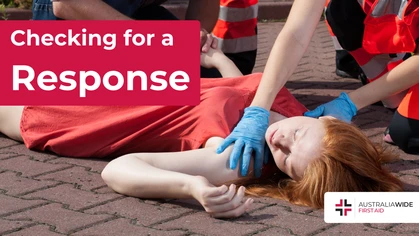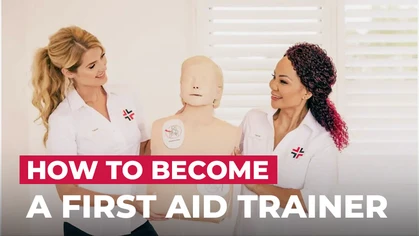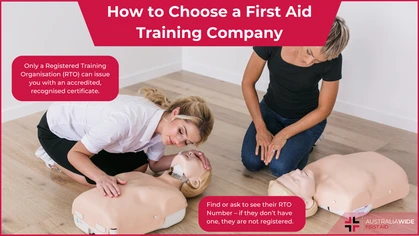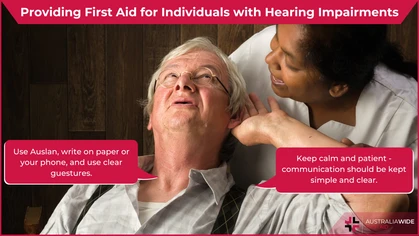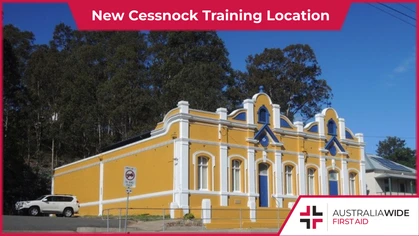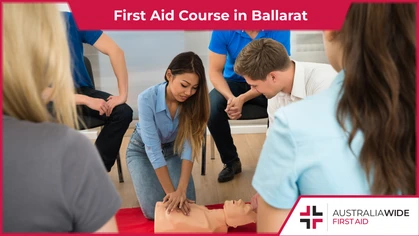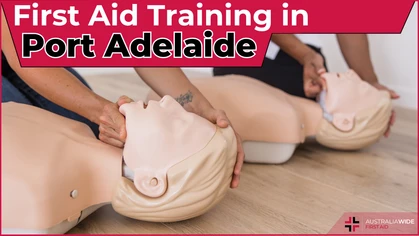Baby First Aid Course Adelaide

First Aid Training
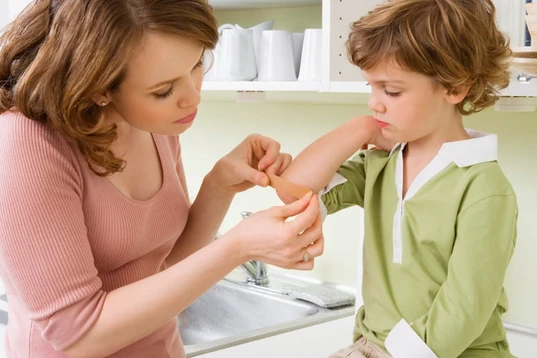
Our baby first aid course Adelaide is designed to provide students with the knowledge and confidence to respond to first aid emergencies that are common among children and infants.
You do not have to be a medical professional to keep your children safe in the face of sudden illness or injury. Our baby first aid course Adelaide course helps parents and childcare and education workers develop the knowledge and skills to manage first aid emergencies that are common among children and infants, including asthma and anaphylaxis. For this reason, our baby first aid course Adelaide is also beneficial to any person who is in regular contact with children and infants, and who wants to be able to preserve life, prevent deterioration, and promote recovery when a medical emergency occurs. Continue reading for more information about our baby first aid course Adelaide and why it consistently produces certified first aiders who are confident, effective, and true assets to their education and care setting. Click here to Enrol Now in our baby first aid course Adelaide.What is First Aid?
Our baby first aid course Adelaide is formally known as HLTAID012 Provide First Aid in an education and care setting, which supersedes HLTAID004 Provide an emergency first aid response in an education and care setting, or HLTAID004 First aid for short. Before we dive into the specifics of our baby first aid course Adelaide, it is important to look at first aid as a whole and why it is worthwhile training for any person who wants to protect their wellbeing and the wellbeing of their loved ones and wider community. First aid refers to the immediate medical assistance provided to a person who has sustained a sudden illness or injury. Having a competent first aider on hand in a medical emergency can mean (and has meant) the difference between life and death. By taking charge of the emergency scene and responding promptly to the casualty’s condition, first aiders can significantly reduce the casualty’s risk of death or permanent disability. First aid training can also improve one’s ability to identify and minimise potential hazards and subpar emergency responses in the home and workplace. For this reason, first aid training is a job requirement for many Australian workers. The importance of first aid is exemplified by its 3 primary objectives – the ‘3 Ps’:1. Preserve Life
The number one responsibility of all first aiders is to preserve life. This means following the DRSABCD Basic Life Support guideline to assess the emergency scene for danger, calling Triple Zero (000) for medical intervention, checking the casualty’s breathing, commencing CPR as necessary, and generally keeping the casualty alive until said medical intervention arrives. DRSABCD is an acronym that denotes the essential action plan for first aid situations. DRSABCD aims to maintain the safety of the casualty and concerned bystanders by prioritising the order of events like so:D: Danger
When you come across a medical emergency, firstly assess the scene for any physical threats to yourself, the casualty, or other bystanders. Examples of danger could include live wires, moving vehicles, or the casualty themselves. If you do not assess the scene for danger, you run the risk of adding more people to the casualty count and making first aid unmanageable.R: Response
Once you have assessed the scene for danger, use the COWS acronym to assess whether the casualty is responsive:- C: Can you hear me?
- O: Open your eyes.
- W: What is your name?
- S: Squeeze my hands.
S: Send for Help
First aid is not a substitute for professional medical attention. As such, once you have assessed the casualty’s responsiveness, shout for someone in your vicinity to call Triple Zero (000) for an ambulance and another to fetch a defibrillator. If no one is around, contact emergency services yourself. And while awaiting their arrival, move onto the next step of the DRSABCD action plan.A: Airway
Check that the casualty’s airway is open and clear by lifting their chin and tilting their head back. If their airway is obstructed by foodstuffs, dentures, or any other foreign item, roll them into the recovery position and sweep the debris out with your fingers. Once you have cleared the casualty’s airway, you should check their breathing, per the next step of the DRSABCD action plan.B: Breathing
Assess whether the casualty is breathing normally by seeing if their chest if rising and falling, by listening at their mouth for sounds of normal breathing, and by placing your cheek near their mouth and feeling for air. If the casualty is breathing normally, roll them into the recovery position, and monitor and treat their condition until the ambulance arrives. If the casualty is not breathing normally, move onto the next letter of the DRSABCD acronym.C: Cardiopulmonary Resuscitation (CPR)
CPR is the essential first procedure for treating a casualty whose heart has stopped beating. CPR imitates the function of the heart and lungs to keep oxygenated blood flowing around the body until definitive treatment can be used to restart the heart. Head to our Chart Library for a comprehensive overview on how to perform effective CPR on adults, children, and infants.D: Defibrillation
If, despite administering CPR, the casualty does not resume breathing or consciousness, use an automated external defibrillator (AED) to restart their heart as necessary. AEDs are portable, compact machines that can deliver an electrical shock to restore muscle contractions and return the heart to its normal rhythms, when appropriate. AEDs come with inbuilt verbal instructions, so simply follow the prompts until the ambulance arrives. Head to our Chart Library for more information on how to apply AED electrode pads to a casualty’s body.2. Prevent Deterioration
As well as preserving life, first aiders are responsible for maintaining the casualty’s condition by providing reassurance and the necessary first aid treatments for different injuries or illnesses, including burns, fractures, and seizures.3. Promote Recovery
The third objective of first aid is to encourage confidence in the patient and relieve their pain, with an end to aid their recovery process. To learn more about the meaning and importance of first aid, head to our Resource Library. From there, you can also enrol in our baby first aid course Adelaide.Baby first aid course Adelaide
Now that we have discussed the value of first aid, it is time to look at our baby first aid course Adelaide and the value it could add to your life as a parent, childcare support worker, or as a person who is regularly in contact with children and infants. In our baby first aid course Adelaide (the formal name for which is HLTAID012 Provide First Aid in an education and care setting) you will develop the knowledge and skills to respond to first aid emergencies that are common in the education and care industry, and among children and infants in general. This includes asthmatic and anaphylactic emergencies. As such, our Baby first aid course Adelaide is trained in accordance with the Australian Resuscitation Council (ARC) guidelines and may contribute towards approved First Aid, asthma, and anaphylaxis training requirements defined by Australian Children’s Education and Care Quality Authority (ACECQA). The mode of delivery for our baby first aid course Adelaide is a blend of online eLearning and face-to-face assessed training. The online eLearning component must be completed at least the night before your baby first aid course Adelaide. It is a multiple-choice quiz that you can attempt as many times as you need with the support of our free First Aid eBook. It is recommended that students allow up to 6 hours to complete the online eLearning component. Once you have completed the multiple-choice quiz, you will get to put your knowledge to the test during the face-to-face assessed training. During this component of our baby first aid course Adelaide, an experienced AWFA trainer will help you demonstrate how to respond to an emergency using DRSABCD, how to perform CPR, how to use an AED, and how to apply first aid principles common to the education and care industry, including asthma, anaphylaxis, and many more. The face-to-face assessed training takes 5 hours in a classroom environment. At our baby first aid course Adelaide, you will be well supported throughout the learning process. Our baby first aid course Adelaide training location (as with our other training locations), is primed for our student’s convenience and kitted out with the following facilities:Parking and transport
Our baby first aid course Adelaide training location has parking within walking distance and can be easily reached by public transport.Facilities
Our baby first aid course Adelaide training location has all the ‘bells and whistles’ to keep you comfortable and engaged throughout the face-to-face assessed training, including toilets, drinking water, classroom-style seating, and hygiene in accordance with infection controls. Baby first aid course Adelaide students also have a scheduled 30-minute lunch break.Trainers
Our baby first aid course Adelaide trainers are industry leaders who not only have a wealth of personal and professional experience in first aid situations, but a penchant for health and wellbeing. Our baby first aid course Adelaide trainers lead by example and work tirelessly to instil their students with the skills and confidence to assist in any medical emergency. For more information about our HLTAID012 Provide First Aid in an education and care setting course, please head to our website. From there, you can also ‘Book Now’ in our baby first aid course Adelaide.Final Thoughts
Our baby first aid course Adelaide is the perfect course for people who live and work in regular contact with children and infants, and who want to develop the skills and knowledge to confidently manage first aid emergencies that are common in education and care settings, including asthma and anaphylaxis. During our baby first aid course Adelaide, you will undertake online eLearning and receive face-to-face assessed guidance from an experienced AWFA trainer, with an end to instil you with the confidence and know-how to preserve life, prevent deterioration, and promote recovery when a medical emergency occurs. You can enrol in our baby first aid course Adelaide today! Simply head to our location page and follow the prompts!
Originally published at
https://www.australiawidefirstaid.com.au/resources/baby-first-aid-course-adelaide
as part of the Australia Wide First Aid Articles Library
